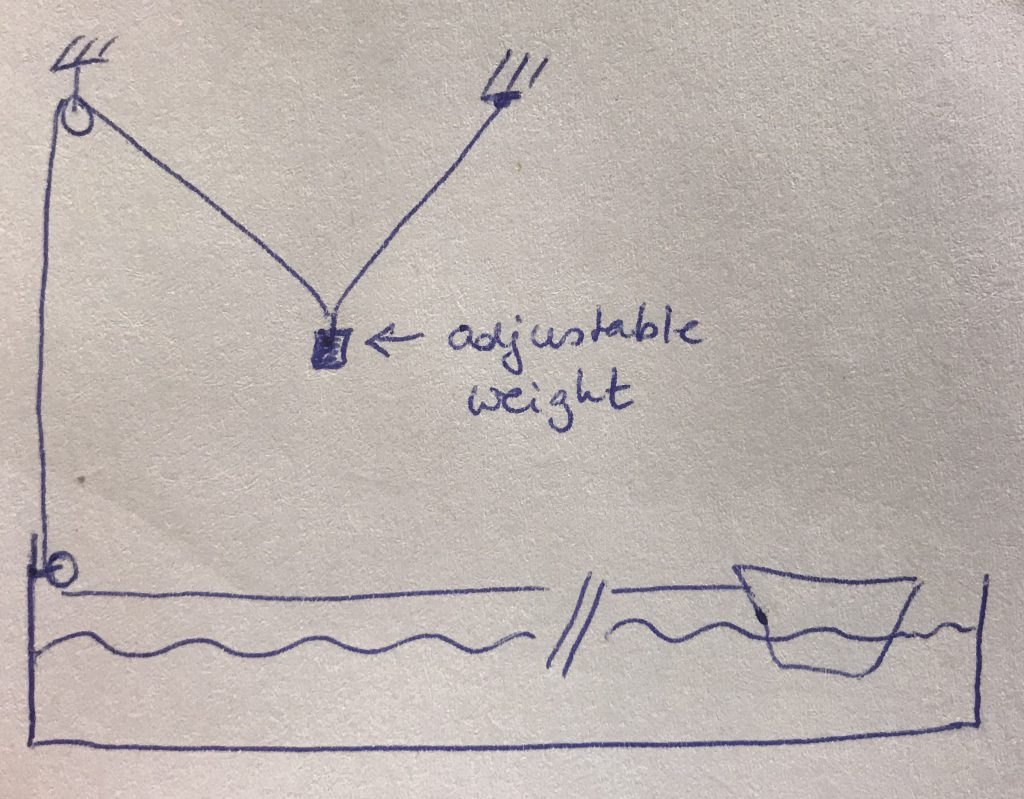
Instructions: Dead water demonstration in the GFI basement
This blog post is meant as guidelines if someone other than me might have to set up this demonstration at some point… Have fun! :-)
Setting up the stratification
If I am working fast and nothing goes wrong, this takes almost 2.5 hours. Make sure you have enough time to set this up! Filling the tank takes time and there is not much you can do to speed up the process once you’ve started…
- Fill in what will end up being the top layer: 5 cm at 0 psu. For this, connect the tap to the bottom inlet in the left corner of the mountain with one of the hoses. When you are done, make sure to close the lock at the tank!
- Move “mountain” over inflow to contain mixing to the volume underneath the mountain (better for your nerves, trust me)
- Prepare the future bottom layers one by one (37,5 cm at 35 psu). We will need four full fillings of the 80l barrel (which doesn’t empty all the way because the tap is slightly elevated from the bottom, in case you were calculating ;-)), each with 2.8kg salt dissolved in it. To prepare that, connect the hose from the tap to the outlet of the barrel, put in the salt, put in the dye, use a paddle while you fill the barrel with water to stir. This way the salt will be pretty much dissolved by the time the barrel is full.
- Note: Make sure the barrel is located high enough so that gravity will pull the water down in the tank from the barrel!
- Note: When the barrel is filled, close the lock at the barrel before disconnecting the hose to reconnect it to the tank!
- Fill in the bottom layers into the tank one by one. While one layer is slowly running into the tank, you have time to measure the salt for the next one.
Pulling the boat
Here is a sketch of the contraption that pulls the boat:

- Put 4 or 5 gram in the little zip lock bag (called “weight” in the sketch above). This only works when the ship is still on the far left end of the tank
- Set up bumper to stop the ship before weights reach the floor (too much slack on the line, line might come off pulleys)
- Stern rope on one of the tank’s braces is set up so the line is stretched as far as it can safely go
- Check that there are marks on the tank which help measuring the speed of the boat (6 marks over 3 meters work well)
Trouble shooting
- If there is suddenly too much friction in the system, check: Did the pulley on the left edge of the tank fall down? Did the rope come off the pulleys (sometimes happens if there was too much slack in the system, e.g. if the bag has been lifted or the bumper is too far left)
- If the boat is moving a lot faster in the beginning than in the end, even though waves haven’t caught up with it, and it bothers you, move the two fixtures that hold the line at the ceiling closer together. Ideally, they should be in the same place, but this didn’t work for us because of tangling lines. Compromise between “constant” force and being able to run the experiment at all…
Observations
Ask students to observe:
- Speed of the boat (actually take the time for a set distance)
- Development of the boat’s speed over time, especially when waves are catching up with it
- Generation of internal waves. Is there one, are there many? What are their wavelengths and speeds?
- Generation of surface waves and their size relative to the internal waves. Why?
Movies
Below are movies of a couple of experiments which you could use in teaching instead of running the experiment for real (if for some reason running the experiment is not possible. But I would totally 100% recommend doing the experiment!). For a fun video, watch the one above (the ones below are cut to only show the tank so might be a little boring less exciting ;-))
Experiment 1
Ship pulled with 5g in the bag
Experiment 2
Ship pulled with 4g in the bag (for a repeat, see experiment 4!)
Experiment 3
Ship pulled with 3g in the bag
Experiment 4
Ship pulled with 4g in the bag (again, because we like repeat experiments ;-))
Explaining Nansen’s “dead water” observation with an experiment – Elin Darelius & Team says:
[…] Instructions for how to set up that experiment can be found here. […]
"Excursion week" in Oceanography 101 while physically distancing - Adventures in Oceanography and Teaching says:
[…] And of course there are tons of books that would lend themselves to that, too, for example xplorer’s diaries. Nansen’s “Farthest North” (1897) for example fits super well if you wanted to talk about the discovery of dead water… […]
Need your help! “Wish list” for a student lab for tank experiments? | Mirjam S. Glessmer says:
[…] “Dead water”, where a ship creates internal waves on a density interface (instructions) […]